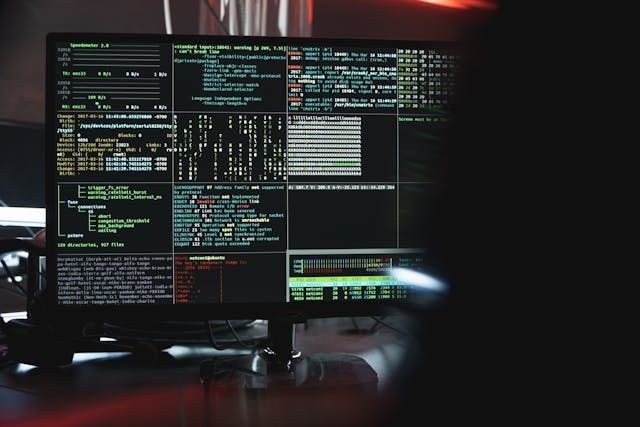What is malware and how to protect yourself against it?
From data breaches to ransomware attacks, malware manifests in various forms, each capable of wreaking havoc on our digital infrastructure, financial status and personal lives. Explore types of malware, its impact, and ways to defend yourself against it.
In today's digital landscape, where technology rules over nearly every aspect of our lives, malware poses a real and inescapable threat. Malicious software, or malware, refers to any software intentionally made to cause damage to individuals, businesses, and even countries.
There is a range of types of malware, including viruses, worms, trojans, ransomware, spyware, adware, and others. All of it designed to steal sensitive data, disrupt computer operations, gain unauthorized access, acquire financial benefit or simply cause chaos. Ramifications of malware attacks are extensive, making malware a constantly evolving threat in the digital world, trying to bypass security measures.
Some of the largest data breaches in history affected millions or even billions of user accounts – like Yahoo data breaches, Marriot data breach, Equifax data breach, Adult Friend Finder data breach and others, causing financial troubles, loss of users' trust, loss of brand reputation, and other problems.
It is essential for individuals and businesses to arm themselves with knowledge and be aware of digital threats. Knowing how malware operates, evolves, and infiltrates our systems is a necessity in safeguarding our digital lives.
What is malware?
Malware or malicious software indicates software designed to intentionally harm a computer system, network, or device. Every type of malware has its own characteristics and mode of operation:
-
Viruses are one of the most common types of malware. They are attached to legitimate programs or files and replicate when the infected program or file is executed. They can corrupt files, slow down system performance or even render the system unusable. Read more about the history and different types of viruses.
- Worms are standalone computer applications that are self-replicating. They do not need a host program to run, cause trouble and infect other files and systems. They spread rapidly through networks and cause widespread damage.

-
Trojans disguise themselves as legitimate programs to trick users into downloading and executing them. Once installed, they perform various malicious activities like stealing sensitive information, or providing remote access to attackers. Well-known examples of Trojans include Rakhni Trojan, distributed using spam emails, Tiny Banker that infects devices in an attempt to compromise their financial accounts and steal funds, and Zeus.
-
Spyware is designed to monitor users' activities, collect information, and transmit it to a third party without consent. It infiltrates systems by bundling with legitimate software or disguising as browser extensions. Spyware often attacks the victims' personal life, giving hackers insight into their private life.
- Ransomware encrypts files and locks users out of their devices, demanding a ransom payment in exchange for restoring access. It often spreads through phishing emails and malicious links, encrypting files and demanding payment in cryptocurrency to decrypt them. How can you protect yourself against ransomware attacks?
Understanding different types of malware is crucial for recognizing and mitigating potential threats, as well as implementing effective security measures to protect against them.
How malware exploits vulnerabilities and infects devices?
Malware exploits system and human vulnerabilities, tricking users into inadvertently installing or executing malicious software. Recognizing these attack methods is crucial for preventing malware attacks.
-
Malicious Attachments: A common point of infection is emails with malicious attachments, such as infected documents or executable files. When users download and open these attachments, they infect the device.
-
Infected Websites: Visiting compromised or malicious websites can lead to malware infections. Cybercriminals can exploit vulnerabilities in web browsers or plugins to inject malicious code into legitimate websites, which infect visitors' devices.
-
Phishing emails: Phishing emails are designed to trick users into downloading malware or disclosing sensitive information. They appear as legitimate messages from trusted organizations or individuals, leading recipients to fraudulent websites with deceptive data forms.
- Social engineering tactics: Cybercriminals often try to manipulate victims into divulging confidential information or into taking actions that lead to malware infections.

Malware takes advantage of weaknesses in software, users' knowledge and lack of attention to infiltrate devices, and systems or access sensitive data without authorization. Software vulnerabilities can exist in operating systems, applications, or browser plugins, which cybercriminals exploit to run harmful code or launch attacks.
Signs of malware infection include slow device performance, unexplained crashes or freezes, unexpected pop-up windows or advertisements, changes to your browser settings or your homepage, unusual network activity, etc.
How to protect yourself against malware attacks?
When it comes to preventing malware attacks, these are good and useful practices:
-
Installing an antivirus or antimalware software that detects and removes malware threats is a must.
-
Regularly updating your operating system, software, and browser plugins with the latest security patches, as updates frequently address known vulnerabilities and bolster defences against cyber threats.
-
Activating firewalls and other security features on your devices creates an additional layer of protection against unauthorized access.
-
Do not install software from untrusted sources, such as random websites you come across.
- Be careful about malvertising: a tactic employed by cybercriminals, involving the purchase of legitimate-looking ads in which they embed malicious code. These ads typically appear at the top of search engine results labeled as 'sponsored.' By mimicking legitimate websites, they deceive unsuspecting users into clicking on them, ultimately redirecting them to malicious websites.
User behaviour plays a critical role in preventing malware attacks. Always be vigilant and exercise caution, do not click on suspicious links or attachments from unknown and untrusted sources. Learn how to identify phishing attempts, detect red flags like misspellings, generic greetings, weird-looking domains in email addresses. Practice safe browsing habits and only download files from official and reputable sources. Do not ignore security warnings from your antivirus program, web browser, or operating system, and do not overlook signs of malware infection. Consider installing a browser extension for ad blocking and malware detection to enhance your browsing security. This can help block malicious ads and warn you about potentially harmful websites. Use strong and unique passwords and enable two-factor authentication for your online accounts, as well as being cautious of unsolicited requests for personal and financial information can help safeguard your data against cyber threats.
More ideas on how to proactively reduce the risk of malware infections.
As part of safe data handling practices and data security, you should also use reliable and secure cloud storage service and regularly back up your important data. This ensures easy data recovery in case of a malware attack.
A few options that can help you simply backup your data to Koofr:
Malware is a serious threat in today's digital world. It can harm businesses, cause financial losses, disrupt operations, compromise sensitive data, and harm reputations. Cybercriminals employ various tactics for infiltrating, exploiting vulnerabilities and user inattention along the way. The key to preventing malware attacks is taking proactive steps to defend ourselves and our systems.
How do you protect yourself against malware attacks? Share your opinion and experience on Koofr subreddit!


